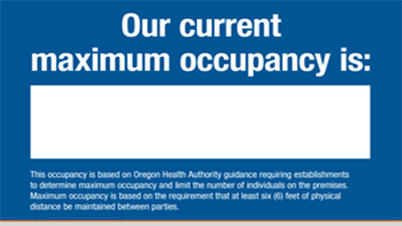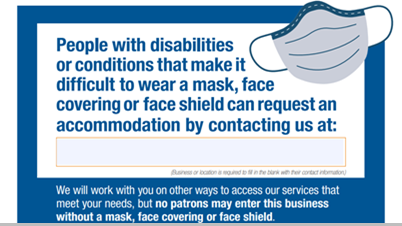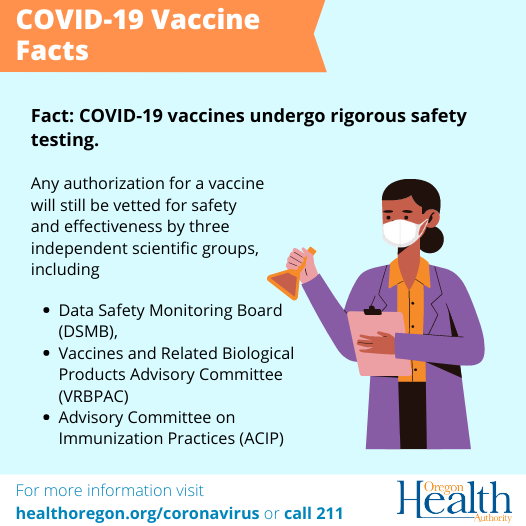For information on COVID-19 in Oregon, call 211 or visit 211info.
You can also dial 1-866-698-6155 or text your zip code to 898211.
Help stop COVID-19 from spreading. Wear a face covering in public. Wash your hands and cover your cough. Stay home if you are sick and avoid contact with people who are sick. If you are having a medical emergency, call 911.
Oregon, Washington and California issue travel advisories
To fight the rapid spread of COVID-19, the governors of Oregon, Washington and California issued travel advisories urging visitors entering their states or returning home from travel outside these states to self-quarantine. The advisories urge against non-essential out-of-state travel, ask people to self-quarantine for 14 days after arriving from another state or country, and encourage residents to stay local.
Oregon’s travel advisory does not apply to people who cross state borders for “essential travel,” including work, study, critical infrastructure support, supply chains, economic services, health, immediate medical care and safety and security.

Statewide Message
Watch
Press Briefing video

Statewide Message
Watch
Press Briefing video

Statewide Message
Watch
Press Briefing video

Statewide Message
Watch
Press Briefing video

Statewide Message
Watch
Press Briefing video

Statewide Message
Watch
Press Briefing video

Statewide Message
Watch
Wastewater Monitoring for COVID-19 video

Statewide Message
Watch
Press Briefing video

Statewide Message
Watch
Press Briefing video

Statewide Facebook Live Broadcast
Watch
Facebook Live video

Statewide Message
Watch
Press Briefing video

Statewide Broadcast
Watch
Town Hall broadcast video

Statewide Facebook Live Broadcast
Watch
Facebook Live video
Situation in Oregon
Dashboards
Daily COVID-19 Update
Updated daily Monday-Friday.
This update includes daily case and testing numbers, demographics, hospital capacity, and emergency department visits.
Overview
| Updated 12/18/2020 with data from 12:01 am (updated Monday - Friday)* | |
|---|---|
| Total cases | 100,308 |
| Total deaths | 1,304 |
| Positive tests | 140,155 |
| Negative tests | 2,275,649 |
| Total tests | 2,415,804 |
Changes to COVID-19 Test Reporting
Starting Dec. 3, 2020, OHA is revising its process for reporting test results to align with the new statewide framework. This new health and safety framework is based on four risk levels for counties level of COVID-19 spread: extreme, high, moderate and lower risk. One of the key new metrics in determining the spread of the virus is the percentage of positive COVID-19 tests. To determine that, OHA will no longer count the people tested and will instead count test results. This change will provide a more complete picture of the spread of the disease in a community.
To support this change, and to maintain transparency in reporting on COVID-19, OHA is changing its public dashboards. That transition is expected to be complete in about two weeks. During that time, OHA will continue to update its Tableau dashboards on weekdays. OHA has developed an interim dashboard to report test results at the state and county levels until the new revised dashboard is deployed.
Cases and Deaths by County (Table)Cases and Deaths by County (Map)Interim Testing Data by County
| Age group | Cases1 | Percent | Ever hospitalized4 | Deaths2 |
|---|---|---|---|---|
| 0 to 9 | 4716 | 5% | 58 | 0 |
| 10 to 19 | 10704 | 11% | 89 | 0 |
| 20 to 29 | 21266 | 21% | 362 | 2 |
| 30 to 39 | 17763 | 18% | 447 | 13 |
| 40 to 49 | 15715 | 16% | 604 | 23 |
| 50 to 59 | 12813 | 13% | 863 | 82 |
| 60 to 69 | 8324 | 8% | 1103 | 186 |
| 70 to 79 | 4947 | 5% | 1165 | 327 |
| 80 and over | 3820 | 4% | 1124 | 671 |
| Not available | 240 | 0% | 22 | 0 |
| Total | 100308 | 100% | 5837 | 1304 |
| Sex | Cases1 | Percent | Deaths2 | Percent |
|---|---|---|---|---|
| Female | 51682 | 52% | 600 | 46% |
| Male | 47812 | 48% | 703 | 54% |
| Non-binary | 6 | 0% | 0 | 0% |
| Not available | 808 | 1% | 1 | 0% |
| Total | 100308 | 100% | 1304 | 100% |
| Hospitalized4 | Cases1 | Percent |
|---|---|---|
| Yes | 5837 | 6% |
| No | 67169 | 67% |
| Not provided | 27302 | 27% |
| Total | 100308 | 100% |
For hospital capacity data: Please see our daily COVID-19 update and Hospital Capacity dashboard.
For data on testing at the Oregon State Public Health Laboratory: Please see our daily COVID-19 update.
1This includes cases confirmed by diagnostic testing and presumptive cases. Presumptive cases are people without a positive diagnostic test who have COVID-19-like symptoms and had close contact with a laboratory confirmed case. Antibody test results are not included in our data. County of residence for cases may change as new information becomes available. If changes occur, we will update our counts accordingly.
2For additional details on individuals who have died from COVID-19 in Oregon, please refer to our press releases.
3This includes cases who test negative and are not epi-linked to a confirmed case.
4Ever hospitalized, if available, as reported to OPERA. OPERA is the state of Oregon’s electronic disease surveillance system for COVID-19. Cases are considered hospitalized if they were ever admitted to the hospital for inpatient care during the their COVID-19 illness. Cases who were examined in but not admitted to a hospital may be incorrectly classified as hospitalized until interview and medical record review are complete, leading to fluctuations in the number of hospitalized COVID-19 cases.
Reports
Weekly COVID-19 Report
This report provides a closer look at COVID-19 risk factors, symptoms, severity, demographics and test positivity.
Weekly Outbreak Report
This report provides information about outbreaks in congregate living settings, workplaces, child care, and K-12 schools.
School Metrics
These metrics help school boards and school districts make decisions about how they can safely reopen schools.
Epidemic Trends and Projections
These projections are intended to be used for planning purposes and are normally updated every three weeks based on Rainier modeling software.
Pediatric COVID-19 Report
This report provides demographic, clinical and epidemiologic details on pediatric cases of COVID-19 in Oregon (under age 18).
OHP (Medicaid) Enrollment Report
This weekly report provides a snapshot of OHP enrollment. The data is preliminary and does not include retroactive enrollments.
*For updates on weekends or previous data reports, please see our COVID-19 News and Reports page. COVID-19 data are provisional and subject to change with ongoing data reconciliation.
Guidance from OHA
| Mask and Face Covering Use in Health Care Offices |
|---|
| Statewide Mask, Face Covering, Face Shield Guidance for Health Care Offices Effective 7/22/2020 Spanish | Arabic | Simplified Chinese | Traditional Chinese | Chuukese | Hmong | Korean | Somali | Marshallese | Russian | Vietnamese |
| Resumption and Continued Provision of Non-Emergent and Elective Procedures |
| Guidance for Hospitals Updated 7/30/2020
Attestation Form |
| Guidance for Ambulatory Surgical Centers Updated 7/30/2020 Attestation Form |
| Guidance for Medical and Dental Offices, Other Health Care Settings Updated 7/31/2020 |
| Recommendations for Veterinary Facilities Updated 12/14/2020 |
Additional OHA guidance for healthcare partners can be found on the pages linked below.
Information for long-term care facilities is available on the DHS website.
OHA provides these materials in multiple languages as a part of our equity-centered response to COVID-19. When there are changes, English versions may be updated before the translated versions. Please check the dates in these documents to make sure you have the most current version. If there are differences between English and another language, the English version is the official version.
Community Resources
Visit our Community Resources page to find information for individuals, families, people with disabilities, caretakers, workers, and more.
As we face COVID-19 together, it's clear that we are strongest when we are in community, even from a distance. To help keep our communities safe and healthy, OHA's Safe + Strong website provides updates, resources and information in multiple languages. With the right information, we can get through this — together.
Safe + Strong Helpline: 1-800-923-HELP (4357)
School Reopening
Oregon public health officials have developed evidence-based metrics to help school boards and school districts make decisions about how they can safely reopen schools. OHA is working closely with the Oregon Department of Education on their Ready Schools, Safe Learners guidance for public and private K-12 schools for the 2020-21 school year.
Social Media Graphics: COVID-19 Vaccine
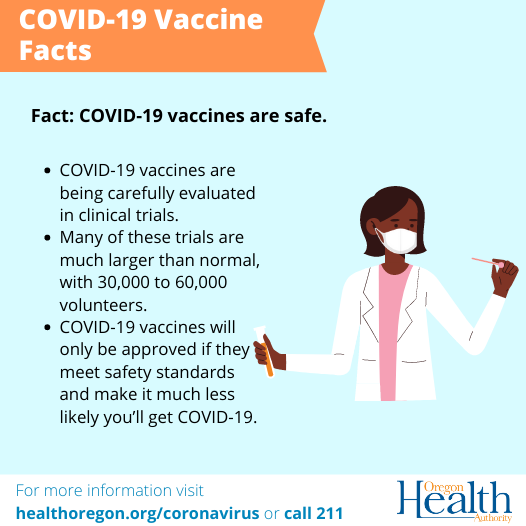
COVID-19 vaccines are being carefully evaluated in clinical trials. They will only be approved if they meet safety standards and make it much less likely you'll get COVID-19.
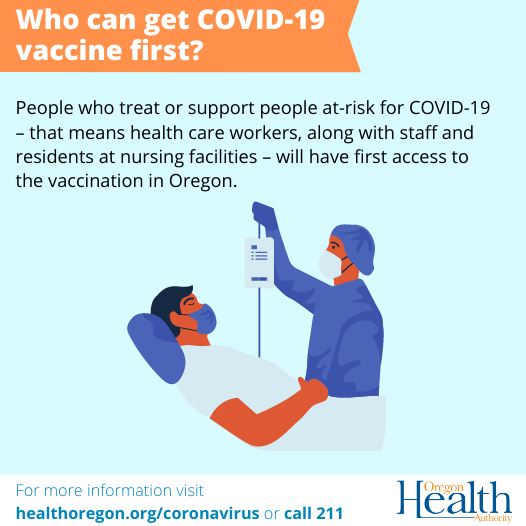
People who treat or support people at-risk for COVID-19 (health care workers; staff and residents at nursing facilities) will have first access to vaccination.
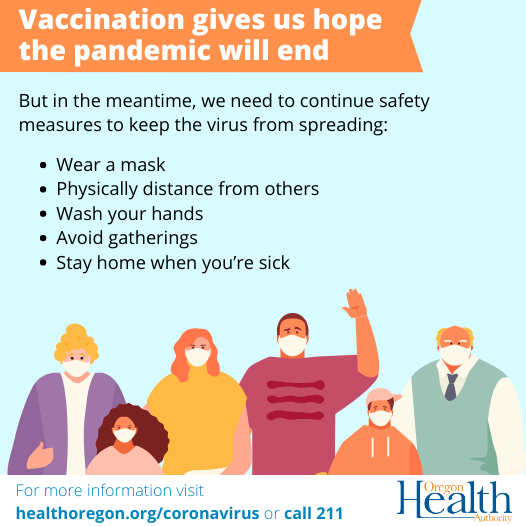
Vaccination gives us hope the pandemic will end, but in the meantime, we need to continue safety measures to keep the virus from spreading.
Accessibility: For individuals with disabilities or individuals who speak a language other than English, OHA can provide information in alternate formats such as translations, large print, or braille. Contact the Health Information Center at 1-971-673-2411, 711 TTY or COVID19.LanguageAccess@dhsoha.state.or.us
Printing requests: You can download materials on this page. OHA does not offer paper versions. Please feel free to print whatever you need.
Language access: OHA is working to provide original content in languages other than English. Many of the materials in our community resources section are available in multiple languages. OHA is also providing the Google™ Translate option to assist you in reading the OHA website in languages other than English. Google™ Translate cannot translate all types of documents and may not provide an exact translation. Anyone relying on information obtained from Google™ Translate does so at their own risk. OHA does not make any promises, assurances, or guarantees as to the accuracy of the translations provided.
General questions: COVID.19@dhsoha.state.or.us
Website feedback: Health.Webmaster@dhsoha.state.or.us
Facebook Español Twitter YouTube




